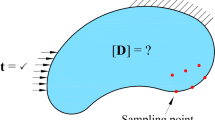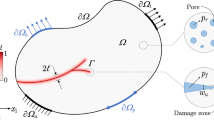Abstract
Propagation of elastic waves in discontinuous media is studied in this paper by the scattering matrix method (SMM). An electromagnetic transmission line analogy is also used to set up the mathematical model. The SMM operates in the frequency domain and allows for all wave polarizations (P, SV and SH). Rock masses are examples of discontinuous media in which the discontinuities (fractures or joints) influence wave propagation. Both elastic and viscoelastic joints are considered and the latter are described by Kelvin–Voigt, Maxwell and Burgers models. Rock joints with Coulomb slip behavior are also analyzed, by applying the averaging principle of Caughy (J Appl Mech 27:640–643, 1960). The evaluation of the effects of periodic discontinuities in a homogeneous medium is presented by introducing the concept of Bloch waves. The dispersion curves of these waves are useful to explain the existence of frequency bands of strong attenuation, also in the case of lossless (perfectly elastic) structures. Simple expressions of transmission and reflection coefficients are obtained. Finally, the SMM results are compared with those computed via the distinct element method (DEM). The comparisons are performed on a medium with joints with Coulomb slip behavior and the agreement is satisfactory, although the SMM must be applied in conjunction with the equivalent linearization technique. Even if the DEM is much more general, the SMM in these simple cases is extremely faster and provides a higher physical insight.


























Similar content being viewed by others
Abbreviations
- A :
-
Transmission matrix
- A N :
-
Absorption coefficient for N joints
- A c :
-
Transmission matrix of the unit cell
- B :
-
Joint compliance matrix
- B :
-
Joint susceptance
- C ij :
-
Elastic constants
- c P±, c SV±, c SH± :
-
Amplitudes of the incident and scattered waves
- c :
-
(3 × 1) matrix containing the above amplitudes
- d :
-
Joint spacing
- D :
-
Amplitude parameter
- e SH±, e SV±, e P± :
-
Velocity vectors
- E A :
-
Amount of energy absorbed by a frictional interface
- E I , E R , E T :
-
Energy flux per unit area per cycle of oscillation associated with incident, reflected and transmitted waves
- f SH±, f SV±, f P± :
-
Traction vectors
- G :
-
Shear modulus
- G f :
-
Shear modulus of the material filling the joint
- h :
-
Joint thickness
- I :
-
Identity matrix
- I A± :
-
Electric current
- i :
-
Cell number, generic index
- Im:
-
Imaginary part of complex number
- j :
-
Imaginary unit, generic index
- K f :
-
Bulk modulus of the material filling the joint
- k :
-
Wave vector
- K :
-
Joint stiffness matrix
- K nn, K ss :
-
Joint normalized normal and shear stiffness
- k 2 :
-
Stiffness parameter
- k eq :
-
Equivalent stiffness
- k P, k S :
-
Wavenumber of P and S-waves
- k nn, k ss :
-
Normal and shear joint stiffness
- k zP, k zS :
-
Wave-vector longitudinal component of P and S-waves
- M :
-
Modal matrix
- N :
-
Number of discontinuities or joints
- n :
-
Scalar parameter
- P :
-
Propagation matrix
- P :
-
Mechanical power
- Re:
-
Real part of complex number
- R N :
-
Reflection coefficient for N joints
- S :
-
Scattering matrix
- S ij :
-
Sub-matrix of the scattering matrix
- T N :
-
Transmission coefficient for N joints
- t :
-
Time
- u :
-
Displacement vector
- v :
-
Velocity
- v :
-
Velocity vector
- v*:
-
complex conjugate of v
- V :
-
Matrix of the eigenvectors of the transmission matrix of the unit cell
- V A± :
-
Electric voltage
- V i :
-
Velocity of propagation of P-waves or S-waves
- V S :
-
Shear wave velocity
- W :
-
System matrix
- x :
-
Relative displacement
- X :
-
Maximum response value
- x, y, z :
-
Spatial coordinates
- \( {\mathbf{\hat{x},\hat{y},\hat{z}}} \) :
-
Unit vectors
- x 0 :
-
Limit elastic displacement
- y p :
-
Normalized admittance
- Y :
-
Admittance matrix or compliance matrix
- Y m :
-
Medium admittance or compliance
- w :
-
Function of the phase-shift ψ between joints
- Z m :
-
Medium or modal impedance
- Z S1, Z S2 :
-
Shear impedances of the media 1 and 2
- α :
-
Phase angle
- Δζ sb :
-
Normalized width of the stop-band
- η :
-
Specific viscosity matrix
- η f :
-
Viscosity of the material filling the joint
- η eq :
-
Equivalent damping
- φ :
-
Phase angle
- \({\overline{\Uptheta}}\) :
-
Parameter function of the limit elastic displacement and of the maximum response value
- ϑ inc :
-
Angle of incidence
- λ :
-
Eigenvalues; wavelength
- λ f :
-
Wavelength of the material filling the joint
- ρ :
-
Mass density
- τ :
-
Stress tensor
- τ:
-
Stress
- τF :
-
Frictional stress
- τ imax :
-
Maximum stress of the incident wave
- τS :
-
Joint shear strength
- τtrasm :
-
Maximum amplitude of the transmitted stress wave
- ω :
-
Wave angular frequency
- ξ :
-
Wave-vector transverse component
- Ψ :
-
State vector
- ψ:
-
Phase-shift between joints
- ζ :
-
Normalized joint spacing ratio
References
Aki K, Richards PG (2002) Quantitative seismology, 2nd edn. University Science Books, California
Al-Bender F, Symens W, Swevers J, Van Brussel H (2004) Theoretical analysis of the dynamic behavior of hysteresis elements in mechanical system. Int J Non-Linear Mech 39:1721–1735
Auld BA (1973) Acoustic fields and waves in solids, vol 1–2. Wiley, New York
Bao H, Hatzor YH, Huang X (2012) A new viscous boundary condition in the two-dimensional discontinuous deformation analysis method for wave propagation problems. Rock Mech Rock Eng. doi:10.1007/s00603-012-0245-y
Boadu FK, Long TL (1996) Effects of fractures on seismic wave velocity and attenuation. Geophys J Int 127:86–110
Cai JG, Zhao J (2000) Effects of multiple parallel fractures on apparent wave attenuation in rock masses. Int J Rock Mech Min Sci 37:661–682
Caughey TK (1960) Sinusoidal excitation of a system with bilinear hysteresis. J Appl Mech 27:640–643
Coates RT, Schoenberg M (1995) Finite-difference modeling of faults and fractures. Geophysics 60:1514–1526
Collin R (1992) Foundations for microwave engineering. Mc Graw Hill, New York
Cook NGW (1992) Natural fractures in rock: mechanical, hydraulic and seismic behaviour and properties under normal stress. Int J Rock Mech Mining Sci Geomech Abst 29(3):198–223
Cundall PA (1971) A computer model for simulating progressive large-scale movements in blocky rock systems. ISRM symposium, Nancy
Fehler M (1982) Interaction of seismic waves with a viscous liquid layer. Bull Seism Assoc Am 72:55–72
Frazer LN (1990) Dynamic elasticity of microbedded and fractured rocks. J Geophys Res 95:4821–4831
Hudson JA (1981) Wave speeds and attenuation of elastic waves in material containing cracks. Geophys J R Astron Soc 64:133–150
Iizuka K (2002) Elements of photonics. John Wiley Interscience, New York
Iwan WD (1973) A generalization of the concept of equivalent linearization. Int J Non-Linear Mech 8:279–287
Jaeger JC, Cook NGW, Zimmerman RW (2007) Fundamentals of rock mechanics, 4th edn. Blackwell Publishing, Oxford
Leucci G, De Giorgi L (2006) Experimental studies on the effects of fracture on the P and S wave velocity propagation in sedimentary rock (“Calcarenite del Salento”). Eng Geol 84:130–142
Li JC, Ma GW (2009) Experimental study of stress wave propagation across a filled rock joint. Int J Rock Mech Min Sci 46(3):471–478
Li JC, Ma GW, Zhao J (2010) An equivalent viscoelastic model for rock mass with parallel joints. J Geophys Res 115:B03305, pp 1–10
Miller RK (1977) An approximate method of analysis of the transmission of elastic waves through a frictional boundary. J Appl Mech 44:652–656
Miller RK (1978) The effects of boundary friction on the propagation of elastic waves. Bull Seismol Soc Am 68(4):987–998
Mindlin RD (1960) Waves and vibrations in isotropic, elastic plates. In: Goodier JN, Hoff JJ (eds) Structural mechanics. Pergamon, New York, pp 199–232
Myer LR, Pyrak-Nolte LJ, Cook NGW (1990) Effects of single fractures on seismic wave propagation. Rock joints. Barton & Stephansson, Balkema, pp 467–473
Perino A (2011) Wave propagation through discontinuous media in rock engineering. Ph.D. thesis, Politecnico di Torino, Italy
Perino A, Barla G, Orta R (2010) Wave propagation in discontinuous media. In: Eurock 2010. Lausanne, pp 285–288, 15–18 June 2010
Pyrak-Nolte LJ (1988) Seismic visibility of fractures. Ph.D. Thesis, University of California, Berkeley
Pyrak-Nolte LJ, Cook NGW (1987) Elastic interface waves along a fracture. Geophys Res Lett 14(11):1107–1110
Pyrak-Nolte LJ, Myer LR, Cook NGW (1990a) Transmission of seismic waves across single natural fractures. J Geophys Res 95(B6):8617–8638
Pyrak-Nolte LJ, Myer LR, Cook NGW (1990b) Anisotropy in seismic velocities and amplitudes from multiple parallel fractures. J Geophys Res 95(B7):11345–11358
Redheffer RM (1960) On a certain linear fractional transformation. J Math Phys 39:269–286
Rokhlin SI, Wang YG (1991) Analysis of boundary conditions for elastic wave interaction with an interface between two solids. J Acoust Soc Am 89(2):503–515
Schoenberg M (1980) Elastic wave behaviour across linear slip interfaces. J Acoust Soc Am 68(5):1516–1521
Slawinski RA (1999) Finite-difference modeling of seismic wave propagation in fractured media. PhD thesis, University of Calgary, Calgary
Van der Hijden JHMT (1987) Propagation of transient elastic waves in stratified anisotropic media. North-Holland, New York
Zhao J, Cai JG (2001) Transmission of elastic P-waves across single fractures with a nonlinear normal deformational behavior. Rock Mech Rock Eng 34:3–22
Zhao J, Zhao XB, Cai JG, Hefny AM (2006a) A further study on P-wave attenuation across parallel fractures with linear deformational behavior. Int J Rock Mech Min Sci 43:776–788
Zhao XB, Zhao J, Cai JG (2006b) P-wave transmission across fractures with nonlinear deformational behavior. Int J Numer Anal Methods Geomech 30:1097–1112
Zhao XB, Zhao J, Hefny AM, Cai JG (2006c) Normal transmission of S-wave across parallel fractures with coulomb slip behavior. J Eng Mech 132:641–650
Author information
Authors and Affiliations
Corresponding author
Rights and permissions
About this article
Cite this article
Perino, A., Orta, R. & Barla, G. Wave Propagation in Discontinuous Media by the Scattering Matrix Method. Rock Mech Rock Eng 45, 901–918 (2012). https://doi.org/10.1007/s00603-012-0286-2
Received:
Accepted:
Published:
Issue Date:
DOI: https://doi.org/10.1007/s00603-012-0286-2




